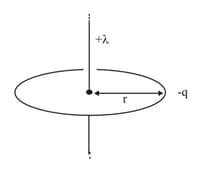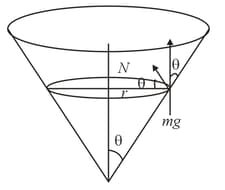Banking of Roads
Banking of Roads: Overview
This topic covers concepts, such as, Horizontal Motion on a Banked Road without Friction, Horizontal Motion on a Banked Road with Friction, Problems Related to Well of Death & Bending of Cyclist on a Banked Road etc.
Important Questions on Banking of Roads
When milk is churned, cream gets separated due to
A car takes a round turn of radius with the velocity of . The centripetal force is:
A ball of mass attached to the end of a string of length is moving in a horizontal circle. The string will break if the tension is more than . What is the maximum speed with which the ball can be moved?
Three particles, each of mass are situated at the vertices of an equilateral triangle of side length . The only forces acting on the particles are their mutual gravitational forces. It is desired that each particle moves in a circle while maintaining the original mutual separation . Find the initial velocity that should be given to each particle and also the time period of the circular motion.
The minimum velocity (in ) with which a car driver must traverse a flat curve of radius and coefficient of friction to avoid skidding is,
A car travels on a banked horizontal road with inclination . What is its maximum speed for not skidding up .
A car is moving on a circular road of radius with a coefficient of friction . With what optimum velocity should the car be moved so that it crosses the turn safely.:
A body is revolving with a constant speed along a circle. If its direction of motion is reversed but the speed remains the same, then,
A string breaks if its tension exceeds . A stone of mass , tied to this string of length , is rotated in a horizontal circle. The maximum angular velocity of rotation can be,
A car of mass is moving with a speed of 10 on a circular path of radius on a level road. What must be the frictional force between the car and the road so that the car does not slip?
The minimum velocity (in ) with which a car driver must traverse a flat curve of radius 150 m and coefficient of friction 0.6 to avoid skidding is
If a cyclist moving with a speed of on a level road can take a sharp circular turn of radius , then coefficient of friction between the cycle tyres and road is
If a car moves on a circular banked road the centripetal force may be provided by :-
A biker initially at rest, starts to move on a circular path of radius with tangential acceleration (constant in magnitude). If on an average bike runs and initially the bike has petrol. The minimum value of the coefficient of friction, so, that bike will not slip during motion is
A stone of mass attached to a long string is whirled around in a horizontal circle at a speed of . The tension in the string is:
When a car of mass passes through a convex bridge of radius with velocity , then it exerts a force on it. What is the magnitude of the force?
A motor cyclist moving with a velocity of on a flat road takes a turn on the road at a point where the radius of curvature of the road is . The acceleration due to gravity is . In order to avoid skidding, he must not bend with respect to the vertical plane by an angle greater than
A particle of charge-q & mass moves in a circle of radius around an infinitely long line charge on linear charge density Then time period will be

A particle describes a horizontal circle of radius r in a funnel type vessel of frictionless surface with half one angle (as shown in figure). If mass of the particle is m, then in dynamical equilibrium the speed of the particle must be –

A disc revolves with a speed of and has a radius of Two coins and are placed at and away from the centre of the record. If the coefficient of friction between the coins and the record is which of the coins will revolve with the record ?
